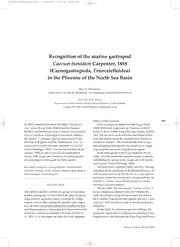
Recognition of the marine gastropod Caecum tumidum Carpenter, 1858 (Caenogastropoda, Truncatelloidea) in the Pliocene of the North Sea Basin PDF
Preview Recognition of the marine gastropod Caecum tumidum Carpenter, 1858 (Caenogastropoda, Truncatelloidea) in the Pliocene of the North Sea Basin
B2015-15:Basteria-2015 11/20/2015 3:12 PM Page 105 Recognition of the marine gastropod Caecum tumidum Carpenter, 1858 (Caenogastropoda, Truncatelloidea) in the Pliocene of the North Sea Basin Dick F. Hoeksema Watertoren28,NL-4336KCMiddelburg,TheNetherlands;[email protected] Jonathan A. Todd DepartmentofEarthSciences,NaturalHistoryMuseum,CromwellRoad, LondonSW75BD,UnitedKingdom;[email protected] tativesoftheCaecinae. 105 In1858Carpenterdescribedthefossil“Caecumtra- InhiscatalogueofshellsfromtheCrag,Wood chea”sensuWood(1842,1848)fromthePliocene (1842:459)listedaspecimenof“Caecumtrachea?” BritishCragMolluscaasnewtoscienceandnamedit foundintheCorallineCrag(Pliocene;Sutton,Suffolk, Caecumtumidum.Alectotypeisselectedtostabilize UK).Thequestion-markindicatesthatWoodatthat thespecies.C.tumidumappearsalsopresentinthe timehaddoubtsaboutthisidentificationthatheex- PlioceneofBelgiumandTheNetherlands.AsC.tu- pressedasfollows,“TherecentBritishshellisregu- midumuntilrecentlyhasbeenmistakenforCaecum larlyannulatedandsmooth,theannuliinmysingle trachea(Montagu,1803)=Caecumimperforatum(Kan- cragspecimenaremoreirregularandrugose.” macher,1798)aswellasforCaecummammillatum InhisMonographoftheCragMollusca,Wood Wood,1848,diagnosticcharactersandphotographs (1848:115-116)omittedthequestion-mark,evidently arepresentedtodistinguishthethreespecies. consideringhisspeciestobeconspecificwiththeRe- centCaecumtrachea(Montagu,1803). Keywords:Gastropoda,Caenogastropoda,Truncatelloidea, TenyearslaterCarpenter(1858:426-427),“having Caecidae,Caecinae,Caecum,Pliocene,NorthSeaBasin,Belgium, subjectedallthespecimensintheBritishMuseum,as TheNetherlands,UnitedKingdom. wellassomesentmebyMr.Wood,toaveryrigidex- aminationunderthemicroscope”,recognizedandde- scribed“C.trachea”sensuWoodasnewtoscience, Introduction namingitCaecumtumidum. Jeffreys(1867:76),discussingC.trachea,wrote,“I ThefamilyCaecidaeconsistsofagroupofinterstitial donotconsideritaBritishfossil;forIbelievethe benthicgastropods,inwhichtheshell,afterthelarval shellsdescribedandfiguredbySearlesWoodfrom stagewhichisregularlycoiled,isformedbyalong, theCorallineCragarenotthisspecies,buthisC.mam- slightlycurvedtube.Duringthegrowth,earlystages millatum.”Jeffreysdidnotrefertothedescriptionby maybeeitherpreserved(subfamiliesStrebloceratinae Carpenter. andPedumicrinae)ordiscardedandtheposteriorend Wood(1872:87)didnotrespondtoJeffreys.He sealedbyaseptum(subfamilyCaecinae)(Pizziniet positivelyrespondedtoCarpenterbyinsertinginhis al.,2013:1).Inthispaperweonlydealwithrepresen- SupplementtotheMonographoftheCragMolluscaa Basteria79(4-6):105-113(2015) B2015-15:Basteria-2015 11/20/2015 3:12 PM Page 106 surveyof“theCragCaecidaeaccordingtoCarpenter’s Material and methods views(thoughIdonotfullyagreewithhim)”,together withafootnoteinwhichWoodremindedreadersofhis Diagnosticcharacters.–Nofronietal.(1997:5)sum- “noteofinterrogationagainstC.trachea”inhiscata- marizedfourvalidlydiagnosticcharactersthatmay logue(Wood,1842:459;seeabove).Despitethisfoot- distinguishCaecumspecies:1.shellsize,2.shapeof note,twoyearslaterin1874,Woodlisted“C.trachea”in septum,3.presence/absenceandtypeof theSynopticalList(page209)andIndex(page224)of (micro-)sculptureand4.presence/absenceofan hisSupplement,merelymentioning“C.tumidum aperturalvarix.Theyadd,“Itisstressedthatthemor- Carp.”inthecolumnof‘Remarks’(page209). phologicalcharactershereemployed(especiallythe Harmer(1923:848)repeatedJeffreys’opinionon septumandthemicrosculpture)arevalidlydiagnostic thefossil“C.trachea”,butfollowedWood:“Jeffreys whenobservedinfull-grown,wellpreservedspeci- consideredthattheCorallineCragfossildescribedby mens;therangeofvariabilityofmanycharactersin Woodunderthepresentnamecouldnotbeidentified someinstance,forcestoanalyseasmanycharactersas withtherecentC.tracheaofMontagu,inwhichthe possibleineachcase,andaslargesamplesaspossible concentricribsaremoredistinctandcloselyarranged, toavoidmisinterpretations.”Forexamplethemi- preferringtoregarditasavarietyofWood’sC.mam- crosculptureshouldnotbehandledastheonlydiag- millatum.Onthewhole,however,…IadoptWood’s nosticfeature,“Oftenspeciesthatareusuallystriate, view,whichistheonemostgenerallyaccepted.” presentspecimenswithveryweak(orevennearlyab- HarmerdidnotevenmentionCarpenter’sdescription sent)microsculpture(andviceversa).” ofC.tumidum. Terminology.–BasedonFretter&Graham(1978: Since1874thetaxonCaecumtumidumCarpenter, 234),Lightfoot(1992:172-173)andNofronietal.(1997: 1858seemstohavebeenforgotten.Unjustly,aswe 4-5):apicalend–thesmaller,narrower,closedupper willshow. endofthetube;septum–closureoftheshellafterthe InpreparationforPartIIoftheatlasDefossiele previousstageisdiscarded;mucro–appendageoften schelpenvandeNederlandsekustHoeksema&Raad visibleontheseptum;aperture–theroundopeningat (2015)studiedthefamilyCaecidae.Thankstothesup- thelowerendofthetube;aperturalend–thelower portofthemembersoftheWerkgroepGeologieofthe endofthetube;varix–transversethickeningorring 106 KoninklijkZeeuwschGenootschapderWetenschap- precedingtheedgeoftheaperture,whichalwayssig- pen(Middelburg,TheNetherlands)adozensamples nifiesanadultshellandtheendofgrowth;dorsalside offossilCaecumspecimenscollectedfromthebeaches –convexsideofthetube(dorsalaspectofseptumis oftheWesterschelde,provinceofZeeland,The “twelveo’clock”);ventralside–concavesideofthe Netherlands,weremadeavailableforstudy.Thesam- tube;ribs–longitudinal,raisedsculpture(equivalent plescontainundisputedspecimensofCaecumglabrum tothespiralsculptureofthenormallycoiledgas- (Montagu,1803)andC.mammillatumWood,1848. tropods);rings–transverse,raisedsculpture(equiva- ShellsofathirdCaecumspeciesatfirstsightresem- lenttotheaxialsculptureofthenormallycoiled bledC.trachea,butacloserexaminationshowedcon- gastropods);microsculpture–sculpturevisibleathigh sistentdifferences.Consequentlythefirstauthor magnification. studiedthefossilCaecumshellsintheRoyalBelgian Systematics.–Thecurrentsystematicsisbasedon InstituteforNaturalSciences(Brussels,Belgium)and theWorldRegisterofMarineSpecies(Bouchet& thosefromDutchboreholesdepositedintheNaturalis Gofas,2015),consultedinJuly2015. BiodiversityCenter(Leiden,TheNetherlands).TheC. Abbreviationsandacronyms.–AR:coll.A.C. trachea-likespeciesispresentinbothmuseums,all (Riaan)Rijken,Middelburg,TheNetherlands;DH: specimenswereobtainedfromPliocenedeposits, coll.D.F.(Dick)Hoeksema,Middelburg,TheNether- whichindicatesthatthebeach-collectedspecimens lands;coll.:collection;fig(s):figure(s);Fig(s):figure(s) alsocanbeconsideredtobeofPlioceneorigin.Study- inthepresentpaper;FN:coll.F.A.D.(Freddy)van ingthepublicationsontheBritishPlioceneCragMol- Nieulande,Nieuw-enSt.Joosland,TheNetherlands; luscamentionedabove,Carpenter’sdescriptionofC. frm(s):fragment(s);GS:coll.G.F.(George)Simons, tumidumappearedstrikinglyapplicabletothisspecies. Middelburg,TheNetherlands;HJ:coll.H.A.A.(Bart) Thesecondauthortrackeddownthespecimensof“C. deJong,Middelburg,TheNetherlands;HR:coll.H.J. trachea”sensuWoodintheNaturalHistoryMuseum (Harry)Raad,Kruiningen,TheNetherlands;LK:coll. (London,UK),thesyntypesonwhichCarpenter(1858: L.(Lex)Kattenwinkel,Goes,TheNetherlands; 426-427)hadbasedhisdescriptionofC.tumidum,and, NHMUK:NaturalHistoryMuseum(formerlyBritish asexpected,theyprovedtobeconspecificwiththe MuseumofNaturalHistory),London,UnitedKing- mentionedfossilC.trachea-likespecimensfromBel- dom;NMR:NatuurhistorischMuseumRotterdam, giumandTheNetherlands. Rotterdam,TheNetherlands;pl(s):plate(s);PM:coll. Basteria79(4-6),2015 B2015-15:Basteria-2015 11/20/2015 3:12 PM Page 107 P.W.(Peter)Moerdijk,Middelburg,TheNetherlands; Pouwer,2013:9-10,fig.1),1spmexcoll.AR, RBINS:RoyalBelgianInstituteforNaturalSciences, RGM.1008223(Fig.7a);2spms,1frmLK;Borssele, Brussels,Belgium;RGM:FossilMolluscacoll.Natu- DeKaloot(provinceofZeeland,TheNetherlands), ralisBiodiversityCenter(formerlyRijksmuseumvan beach,2spms(Figs4-6),2frmsFN;4spms,5frms GeologieenMineralogie),Leiden,TheNetherlands; HJ;2spms,1frmHR;1frmPM;Nieuwvliet,Zwarte spm(s):specimen(s);WoRMS:WorldRegisterofMa- Polder(provinceofZeeland,TheNetherlands), rineSpecies(Bouchet&Gofas,2015). beach,1frmHR;Domburg(provinceofZeeland,The Typematerial.–IntheNaturalHistoryMuseum Netherlands),beach,1spm,RGM,excoll.J.vanDal- (London,UK),notypespecimensselectedbyCarpen- sum(infortunatelylost). terhimselfcouldbefound.Theonlysampleof“C. Specimenslabeledas“C.imperforatum”inRGM trachea”fromtheCorallineCragFormationislot fromPliocenedepositsinboreholesinTheNether- NHMUKPIG2066,donatedtothemuseumbyWood landsallappearedtobelongtoC.tumidum(April (Fig.1).Thewholelotcomprises19specimensad- 2015). heredtoathinblackpaperstripgluedontoathicker InadditiontothespecimensofC.tumidumthe whitepieceofcard.Originallyatleastanotherfour firstauthorstudiedforcomparisonasampleof specimenswerepresent,butatsometimethesehave beachedspecimensoffreshdeadC.trachea(excoll. beenremovedandthepresentwhereaboutsofthese G.J.Geuze,DH;Figs11-14)fromMartinhal,S.Portu- shellsareunknown.Onthecardonecanreadin gal,andsamplesofC.mammillatumwashedashoreat Wood’shandwritinginpencil“Cor.Crag/Caecum thebeachesofBaarland(seeabove;AR,LK;Figs15- trachea?/Sutton”;acrossandgreenstickerindicate 17),Borssele/DeKaloot(FN,HJ,HR),Ritthem(GS), thespecimenthathasbeenfigured(Wood,1848:pl. Vlissingen(HR),Nieuwvliet/ZwartePolder(HJ)and 20fig.5),whichisconfirmedbyacrossonthemu- DeBanjaard(HJ),provinceofZeeland,TheNether- seumlabel(Fig.2).AsCarpenter(1858:427)basedhis lands. descriptionofC.tumidumon“allthespecimensinthe BritishMuseum,aswellassomesentmebyMr. Systematics Wood”andasall19specimensseemconspecific,lot NHMUKPIG2066canbeconsideredatypeseriesof ClassGastropodaCuvier,1795 syntypes.Thespecimenwhichhasbeenfigured SubclassCaenogastropodaCox,1960 107 (Wood,1848:pl.20fig.5)andtowhichCarpenter OrderLittorinimorphaGolikov&Starobogatov,1975 (1858:427)referredinhisoriginaldescription,ishere SuperfamilyTruncatelloideaGray,1840 selectedaslectotypeandrenumberedNHMUKPI FamilyCaecidaeGray,1850 G2066(1)(Fig.3),makingtheother18specimens SubfamilyCaecinaeGray,1850 paralectotypes.Thelectotypeis2.79mmlongand amongthelargestofthe19typespecimens. CaecumFleming,1813 Othermaterialexamined.–BergenopZoom (provinceofNoord-Brabant,TheNetherlands),bore- CaecumtumidumCarpenter,1858(Figs3-10) hole2,RvD9283,90-91mbelowsurface,Oosterhout Formation–mollusczoneMolD1,Pliocene(Piacenz- Caecumtrachea?-Wood,1842:459(question-markbyWood). ian),1spm,RGM.937740;Dongen(provinceof NotC.tracheaMontagu,1803. Noord-Brabant,TheNetherlands),borehole Caecumtrachea–Wood,1848:115-116,pl.20fig.5;1872:87; B44G.0043,175-176mbelowsurface,OosterhoutFor- 1874:209,224.Harmer,1923:847-848,pl.64fig.32.Trausel mation–mollusczoneMolD1,Pliocene(Piacenzian), &Slieker,2015:NMR26235.NotC.tracheaMontagu,1803. 1spm,RGM.937737.a(Figs7b,8-10);Kallo(province Caecum(Anellum)tumidum–Carpenter,1858:426-427. ofOost-Vlaanderen,Belgium),Verrebroekdok,Lillo Caecummammillatum–Jeffreys,1867:76.Marquet,1997:18,28- Formation,OorderenMember,Atrinalevel,Pliocene 29fig.3;1998:70fig. (Piacenzian),1spm,RBINSno.IRScNBIST5897 Caecumimperforatum-VanRegterenAltena,Bloklander&Poud- (Marquet,1997:18,28-29;Marquet,1998:70fig.;asC. eroyen,1955:29,pl.6fig.58;1965:17,pl.6fig.58. mammillatum);Kallo,Deurganckdok,LilloFormation, LuchtbalorOorderenMember,Pliocene(LateZan- Originaldescription.–Caecum(Anellum)tumidum cleantoPiacenzian),4spms,LK;Baarland(province Carpenter,1858. ofZeeland,TheNetherlands),beachnearCamping Testatereti,sublaeviseuannulisobsoletisornata;aper- Scheldeoord,insanddredgedfromtheWester- turahaudcontracta,annulotumidocincta;septomamil- scheldeatthe‘OverloopvanHansweert’and/orthe lato,plusminusvetumente;marginelateraliconvexo, ‘DrempelvanHansweert’intheWesterscheldeestu- dorsumversussubangulato;operculum?-. ary,derivedfromPliocenedeposits(Moerdijk& Long.0.11,lat.0.018-0.024. Hoeksema, D.F. & Todd, J.A.–CaecumtumiduminthePlioceneoftheNorthSeaBasin B2015-15:Basteria-2015 11/20/2015 3:12 PM Page 108 108 Figs1-10.Caecumtumidum,Carpenter,1858.1,typeseriesfromtheCorallineCragFormation,Pliocene(Zanclean),Sutton,Suffolk,UK, NHMUKPIG2066;2,museumlabelofNHMUK,withacrossindicatingthatthecrossonthecardofthetypeseriesindentifiesthefig- uredspecimen;3,lectotype,length2.79mm,NHMUKPIG2066(1)=thespmpicturedbyWood(1848:pl20fig5);4-6,2spms,length2.7 and2.9mm,washedashoreatBorssele,DeKaloot,FN;4,scale500micrometer;5,aperturalendFig4a,showingavarix,scale100mi- crometer;6,detaillowerparttubeFig4a,showingmicroscopicpitting,scale50micrometer;7-10,2spms;7,scale500micrometer;7a,1 spm,length2.5mm,Baarlandbeach,provinceofZeeland,TheNetherlands,Pliocene,excoll.AR,RGM.1008223;7b,1spm,length2.8 mm,Dongen(provinceofNoord-Brabant,TheNetherlands),boreholeB44G.0043,175-176mbelowsurface,OosterhoutFormation– mollusczoneMolD1,Pliocene(Piacenzian),RGM.937737.a;8,aperturalendFig7b,scale100micrometer;9,apicalend,scale100mi- crometer;10,detaillowerparttubeFig7b,showingmicroscopicpitting,scale50micrometer. Basteria79(4-6),2015 B2015-15:Basteria-2015 11/20/2015 3:12 PM Page 109 Hab.Sutton,Cor.Crag.Mus.Brit.&c. oftenshowsathickeningoranelevatedsmoothring =C.trachea,SearlesWood,Crag.Moll.p.115,pl.20,f. precedingtheedgeoftheaperture(Figs4-5,7-8;com- 5(?pars),nonMont.etauct. pareVanRegterenAltenaetal.,1955&1965:pl.6fig. [Shellslender,round,almostsmoothorobsoletely 58,asC.imperforatum).Dimensionsofthelongest annulated;aperturenotconstricted,withswollen specimenmeasured(Fig.4b):length2.93mm,diame- ring;septummamillate,moreorlessswollen;lateral ter0.49mm(apicalend)-0.62mm(aperture);meas- sides(i.e.hacspeciedorsali(Carpenter,1858:420)=ob- uredlikeL,dandDinfig.2ofPortaetal.(1993:3). servedfromthedorsalside)convex,dorsalsidein- Locustypicus.–Sutton,Suffolk,UnitedKingdom clinedtobeingsomewhatangular;operculum Stratumtypicum.–RamsholtorSudbourneMem- unknown.Length2.79mm,diameter0.46-0.61mm]. ber,CorallineCragFormation,Pliocene(LateZan- Remarks:Carpenter’smeasurementsareininches, clean). 1.0inch=25.4mm.AccordingtoSclater(1893:440), Distribution.–C.tumidumiswidelydistributedin pages413-432ofCarpenter’spaperwerepublishedin thePlioceneoftheNorthSeaBasin,geographically 1858,andpages433-448in1859.AsC.tumidumwas fromUnitedKingdom(Sutton,Suffolk)toBelgium describedonpages426-427,theyearofpublicationof (provinceofOost-Vlaanderen)andTheNetherlands thisspeciesis1858. (provincesofZeelandandNoord-Brabant)andstrati- Diagnosis.–AfossilCaecumwithanentirelyor graphicallyfromLateZanclean(CorallineCragFor- partiallytransverselyrugosetube;theseptumele- mation,UnitedKingdomandpossiblyLuchtbal vated,hemispherical,obliquelytruncatedwithakeel Member,Belgium)toPiacenzian(OorderenMember, andtheaperturalendoftenwithavarix.Sometimes BelgiumandOosterhoutFormation–mollusczone microscopicpits,largestbetweentherugae.Length: MolD1,TheNetherlands). 2.9mm. Reviseddescription.–Theadultshellisaminute, Discussion brittle,regularlycurvedtube.Thesurfaceoftheshell usuallybears,entirelyorpartially,irregular,rugose, InthestudyofC.tumidumthreeothertaxaplayan ring-shaped,transversethickenings(Figs3-10).The importantrole,viz.C.imperforatum(Kanmacher, tubeandseptumshowanirregularpatternofmicro- 1798),C.trachea(Montagu,1803)andC.mammillatum scopicpits,largestbetweentherugae(Marquet,1997: Wood,1848.AccordingtoWoRMS(consultedinJuly 109 18,28-29fig.3,1998:70fig.;Figs5-6,8-10).Theapical 2015)C.imperforatumhastobeconsideredadubious endissealedbyanelevated,moreorlesshemispheri- synonymofC.trachea. calseptum,oftensomewhatobliquelytruncatedat Caecumtrachea(Figs11-14)occursfromthe theventralsideandcylindricalwithakeelatthedor- Mioceneuntilthepresentdayandisstillacon- salside(thekeelisusuallypositionedat12o’clockto stituentoftheRecentEuropeanandNWAfrican 3o’clock,sometimesalsoweaklypresentaroundthe fauna.Thetubeisentirelyorpartiallycoveredwith restoftheseptum;Figs4,7,9).Theaperturalend rings,theapicalendwithasomewhatsunkenseptum C.tumidum C.trachea C.mammillatum Figs3-10 Figs11-14 Figs15-17 entirelyorpartiallywithtrans- entirely,sometimespartially, entirelysmoothorwithsomefainttrans- macrosculpturetube verselyrugose,ring-shaped coveredwithrings versering-shapedthickenings thickenings microsculpturetube irregularpits oftenlongitudinalstriae oftenlongitudinalstriae elevated,hemispherical, somewhatsunk,witharounded sunk,withanarrowpapilliform septum obliquelytruncated,withakeel mucro roundedmucro sometimeswithathickeningoranele- oftenwithathickeningoranele- sometimeswithathickening vatedsmoothringprecedingtheedgeof aperturalend vatedsmoothringprecedingthe precedingtheedgeoftheaper- theaperture,and/oranarrowengraved edgeoftheaperture ture ringatsomedistancefromtheaperture maximumlength 2.9mm 3.8mm 3.4mm Table1.C.tumidumshowsconsistentdifferencesfromC.tracheaandC.mammillatum. Hoeksema, D.F. & Todd, J.A.–CaecumtumiduminthePlioceneoftheNorthSeaBasin B2015-15:Basteria-2015 11/20/2015 3:12 PM Page 110 110 Figs11-14.Caecumtrachea(Montagu,1803),1spm,length2.8mm,Martinhalbeach,Algarve,S.Portugal,Recent,excoll.G.J.Geuze,DH; 11,scale500micrometer;12,aperturalend,scale100micrometer;13,apicalend,scale100micrometer;14,detailtube,showingmicro- scopiclongitudinalstriae,scale50micrometer. withaprotruding,eccentric(12-1o’clock),rounded fromPliocenedepositsintheNorthSeaBasin.The mucro,theaperturalendsometimeswithathickening tubehasasmoothsurface,sometimeswithsomefaint precedingtheedgeoftheaperture.Oftenami- rings,theapicalendwithasunkenseptumwithanar- crosculptureoflongitudinalstriae.Length:3.8mm. row,(oftenvery)protruding,eccentric(12-1o’clock), (VanAartsen,1977:15figs22-23,17;Chirli,2006:66- papilliform,roundedmucro,theaperturalendsome- 68,pl.28figs7-10;Chirli&Linse,2011:89,pl.26fig. timeswithathickeningoranelevatedsmoothring 3a;Fretter&Graham,1978:233-234;Jeffreys,1867:75- precedingtheedgeoftheaperture,and/oranarrow 77;Landauetal.,2004:pl.14fig.1,61-62;VanderLin- engravedringatsomedistancefromtheaperture den&Moolenbeek,2000:89-91figs27-28;Panetta, (compareVanRegterenAltenaetal.,1955&1965:pl.6 1980:288-289,294-295figs4-6;Portaetal.,1993:2-5 fig.56).Oftenamicrosculptureoflongitudinalstriae. figs1-9). Length:3.4mm.(Wood,1848:116,pl.20fig.4; Caecummammillatum(Figs15-17)isafossilCaecum Harmer,1923:847,pl.64fig.31;VanRegterenAltena Basteria79(4-6),2015 B2015-15:Basteria-2015 11/20/2015 3:12 PM Page 111 Figs15-17.CaecummammillatumWood,1848,1spm,length3.4mm,showingmicroscopiclongitudinalstriae,Baarlandbeach,province 111 ofZeeland,TheNetherlands,Pliocene,excoll.AR,RGM.1008222;15,scale500micrometer;16,aperturalend,showingavarix,scale100 micrometer;17,apicalend,scale100micrometer. etal.,1955:29,1965:17,pl.6fig.56;Hoeksema& C.trachea.Mostlikelyalsofig.9ofHoeksema&Raad Raad,2015:28fig.10).Theseptumlookssomewhat (2015:28;asC.trachea)canbereferredtosuchaspeci- likethatoftheRecentCaecumvitreumCarpenter,1859 menofC.mammillatum(herefiguredinFig.18).So (Nofronietal.,1997:9fig.16). Wood’sfig.5amayrepresentC.tracheaorperhaps ThemicrosculptureonthetubeofaCaecumshell, C.mammillatum,butnotC.tumidum. ifpresent,isusuallyonlyvisibleonwellpreserved StudyingsurveysoftheEuropeanandNorth specimens.ItcanbeobservedonC.tumidum,C.tra- AfricanCaecidae,neitherthepresentdayfauna(Van cheaandC.mammillatumusingobliquelightingatmi- Aartsen,1977;Panetta,1980;Nofronietal.,1997;Van croscopemagnificationsgreaterthanrespectively derLinden&Moolenbeek,2000)norotherfossilfau- 40x,40xand10x. nas(Portaetal.,1993;Landauetal.,2004;Chirli,2006; ConsideringthespecimensofC.tumidumnow Chirli&Linse,2011)containaCaecumspeciesmatch- presentinthetypeseries,thedescriptionof“C.tra- ingC.tumidum.Theseptumofthepresentspecies, chea”sensuWood(1848:115-116,pl.20fig.5)isnot moreorlesshemisphericalwithakeel,mostclosely accurateinallrespects.Theobservations“length1/8 resemblesthatofCaecumarmoricumDeFolin,1869, ofaninch”(=about3.18mm)and“theclosedtermi- butthetubeofthatRecentspeciesissmooth,witha nationpreciselyresemblingtherecentspeciesin delicatelongitudinalmicrosculptureandwithoutan beingobliquelytruncatedandobtuselypointed”are aperturalvarix(Hoeksema&Segers,1993:81,82figs notcorrect.Thefigs5(withlongitudinalstriae,clear- 1A-E2A-D,85,87fig.7A-B).Theirregular,rugose, estvisiblebetweentherings)and5a(aseptumwith ring-liketransversethickeningsarereminiscentof roundedmucro)arereminiscentofC.trachea.In CaecumgougerotiMoroni&Ruggiere,1985,butthe Carpenter’s(1858:427;1859:435)opiniontheseptum transversethickeningsonthesurfaceofthisMiocene- offig.5aprobablyfitswithintherangeofvariationof Pliocenespeciesaremainlyconcentratedontheapi- C.mammillatum,someformslikefig.5aapproaching calendofthetubeandtheseptumofC.gougeroti Hoeksema, D.F. & Todd, J.A.–CaecumtumiduminthePlioceneoftheNorthSeaBasin B2015-15:Basteria-2015 11/20/2015 3:12 PM Page 112 den,TheNetherlands)andAuke-FlorianHiemstrafor makingFigs4-17.WethankTomMeijerandRonald Pouwerforinformationonthepalaeontologicalageof theRGMsamples.PeterMoerdijkisacknowledgedfor hissuggestionstoimprovethetranslationoftheorigi- naldescription.FinallywethankArieJanssenand BernardLandauforcriticallyreviewingthemanu- script. References Fig18.Caecumcf.mam- millatumWood,1848.1 Aartsen,J.J.VAN,1977.RevisionoftheEastAtlanticand wornspm,showingaC. MediterraneanCaecidae.—Basteria41(1-4):7-19. trachea-likeseptum, Bouchet,P.&Gofas,S.,editors,2015.WorldRegisterofMarine length2.7mm,Domburg Species(WoRMS),Mollusca.–www.marinespecies.orgon beach,provinceofZee- 2015-07-31. land,TheNetherlands, Bruyne,R.H.de,Leeuwen,S.J.van,GmeligMeyling,A.W.& Pliocene,excoll.M. Daan,R.,(red.),2013.SchelpdierenvanhetNederlandseNo- Donze,RGM.794216. ordzeegebied.Ecologischeatlasvandemarieneweekdieren (Mollusca).UitgeverijTirion,UtrechtenStichtingAnemoon, Lisse. showsatriangular,roundedmucro(Chirli,2006:63- Carpenter,P.P.,1858-1859.FirstStepstowardsaMonographof 64,pl.27figs5-8). theCaecidae,aFamilyofRostriferousGasteropoda.–Pro- Caecumtumidumseems,likeC.mammillatum,tobe ceedingsoftheZoologicalSocietyofLondon26:413-432 restrictedtothePlioceneoftheNorthSeaBasin,the (1858),433-444(1859). latterbeingthecommonestspeciespresent.C.glabrum Chirli,C.,2006.MalacofaunaPliocenicaToscana,Vol.5 isrelativelyrareinthePlioceneoftheNorthBasin CaenogastropodaCox,1959Part1:1-144,pls1-46.Firenze. 112 (Wood,1848:117;Marquet,1997:18-19,1998:71),but Chirli,C.&Linse,U.,2011.ThePleistoceneMarineGastropods remainsaconstituentoftheNEAtlanticandNorth ofRhodesIsland(Greece):1-447.Firenze. Seafauna(Fretter&Graham,1978:234-235;De Fretter,V.&Graham,A.,1978.TheProsobranchMolluscsof Bruyneetal.,2013:205).AfourthPlioceneCaecum- BritainandDenmarkPart4MarineRissoacea.–TheJournal speciesfromtheNorthSeaBasin,CaecumliratumCar- ofMolluscanStudies,Supplement6:153-241. penter,1858,isonlyknownfromtheCorallineCrag Harmer,F.W.,1923.ThePlioceneMolluscaofGreatBritain FormationofSuttonbytheholotypeintheNatural beingsupplementarytoS.V.Wood’sMonographoftheCrag HistoryMuseum(London,UK)andwhichrequires Mollusca,Vol.2,Part3.-MonographofthePalaeontograph- re-study(Carpenter,1858:421).Incontradictiontothe icalSocietyLondon75(352):705-856,pls57-64.. distributiongivenbyChirli(2006:67-68)andChirli& Hoeksema,D.F.&Raad,H.J.,2015.Defossieleschelpenvande Linse(2011:89),weconcludethatthepresenceoffos- NederlandsekustII,deel10.Hydrobiidae,Cochliopidae, silC.tracheaintheNorthSeaBasinstilllacksconvinc- Iravadiidae,TruncatellidaeenCaecidae.–Spirula402:24-29. ingevidence. Hoeksema,D.F.&Segers,W.,1993.Onthesystematicsanddis- tributionofthemarinegastropodCaecumarmoricumDe Acknowledgements Folin,1869(Prosobranchia,Caecidae).–GloriaMaris31(6): 79-88. WearegratefultoGerardGeuze,BartdeJong,Lex Jeffreys,G.W.,1867.BritishConchology,oranaccountofthe Kattenwinkel,PeterMoerdijk,FreddyvanNieulande, MolluscawhichnowinhabittheBritishIslesandthesur- HarryRaad,RiaanRijkenandGeorgeSimons(Werk- roundingseas.Vol.4:1-486,pls1-8.VanVoorst,London. groepGeologie,KoninklijkZeeuwschGenootschap Landau,B.,Marquet,R.&Grigis,M.,2004.TheEarlyPliocene derWetenschappen,Middelburg,TheNetherlands) Gastropoda(Mollusca)ofEstepona,SouthernSpain.Part2: fortheloanordonationofmaterialandallowingusto Orthogastropoda,Neotaenioglossa.–Palaeontos4:1-108. publishtheirrecords.WethankAnneliseFolieand Lightfoot,J.,1992.CaecidaeoftheWesternAtlantic.Part1.–Of RobertMarquetformakingavailabletheCaecumma- SeaandShore14(4):171-185. terialintheRoyalBelgianInstituteforNaturalSci- Linden,J.vander&Moolenbeek,R.G.,2000.Caecidae(Mol- ences(Brussels,Belgium).WethankFrankWesselingh lusca:Gastropoda)fromMauritania.–VitaMarina47(3):81- andRonaldPouwerforallowingustostudytheCae- 92. cumsamplesintheNaturalisBiodiversityCenter(Lei- Marquet,R.,1997.PliocenegastropodfaunasfromKallo(Oost- Basteria79(4-6),2015 B2015-15:Basteria-2015 11/20/2015 3:12 PM Page 113 Vlaanderen,Belgium).Part2.Caenogastropoda:Potamidi- 1955.DefossieleschelpenvandeNederlandsestrandenen daetoTornidae.–ContributionstoTertiaryandQuaternary zeegaten,2.–Basteria19(2-3):27-34,pls5-8. Geology34(1-2):9-29. RegterenAltena,C.O.van,Bloklander,A.&Pouderoyen,L.P., Marquet,R.,1998.DepliocenegastropodenfaunavanKallo 1965.DefossieleschelpenvandeNederlandsestrandenen (Oost-Vlaanderen,België):1-246.Publicatieno.17,Belgis- zeegaten.Eersteserie,tweededruk:1-55,pls1-22.Neder- cheVerenigingvoorPaleontologie,Antwerpen. landseMalacologischeVereniging,Leiden. Moerdijk,P.W.&Pouwer,R.,2013.Laevastartequiespacisnov. Sclater,W.L.,1893.ListoftheDatesofDeliveryoftheSheetsof spec.(Mollusca,Bivalvia,Astartidae)fromthePlioceneof the‘Proceedings’oftheZoologicalSocietyofLondon,from TheNetherlands.–CainozoicResearch10(1-2):9-13. thecommencementin1830to1859.–ProceedingsoftheZo- Nofroni,I.,Pizzini,M.&Oliverio,M.,1997.Contributiontothe ologicalSocietyofLondon61:435-440. knowledgeofthefamilyCaecidae.3.RevisionoftheCaeci- Trausel,J.&Slieker,F.,2015.NMR26235.-www.nmr-pics.nl> daeoftheCanaryIslands(Caenogastropoda:Rissooidea).– Caecidae>PLEISTOCENECaecumtrachea(Montagu, Argonauta10(7-12):3-32. 1803)on2015-07-31. Panetta,P.,1980.LafamigliaCaecidaenelMediterraneo.–Bol- Wood,S.V.,1842.ACatalogueofShellsfromtheCrag.–The lettinoMalacologico16(7-8):277-300. AnnalsandMagazineofNaturalHistory9:455-462,pl.5. Pizzini,M.,Raines,B&Vannozzi,A.,2013.ThefamilyCaecidae Wood,S.V.,1848.AMonographoftheCragMollusca:Vol.1 intheSouth-WestPacific(Gastropoda:Rissooidea).–Bollet- Univalves-MonographofthePalaeontographicalSociety tinoMalacologico49,Suppl.10:1-78. London1(1):i-xii,1-208,pls1-21. Porta,J.de,Martinell,J.&GonzálezDelgado,J.A.,1993.Caeci- Wood,S.V.,1872.SupplementtotheCragMollusca,Vol.3Uni- dae(Gastropoda,Mesogastropoda)delNeógenoyCuater- valvesandBivalves,Part1–MonographofthePalaeonto- narioMarinosdelMediterráneoNoroccidentalydela graphicalSocietyLondon25(113):i-xxxi,1-99,pls1-7. PenínsulaIbérica.–RevistaEspañoladePaleontología8(1): Wood,S.V.,1874.SupplementtotheCragMollusca,Vol.3Uni- 1-13. valvesandBivalves,Part2-MonographofthePalaeonto- RegterenAltena,C.O.van,Bloklander,A.&Pouderoyen,L.P., graphicalSocietyLondon27(123):100-231,pls8-11+add.pl. 113 Hoeksema, D.F. & Todd, J.A.–CaecumtumiduminthePlioceneoftheNorthSeaBasin
